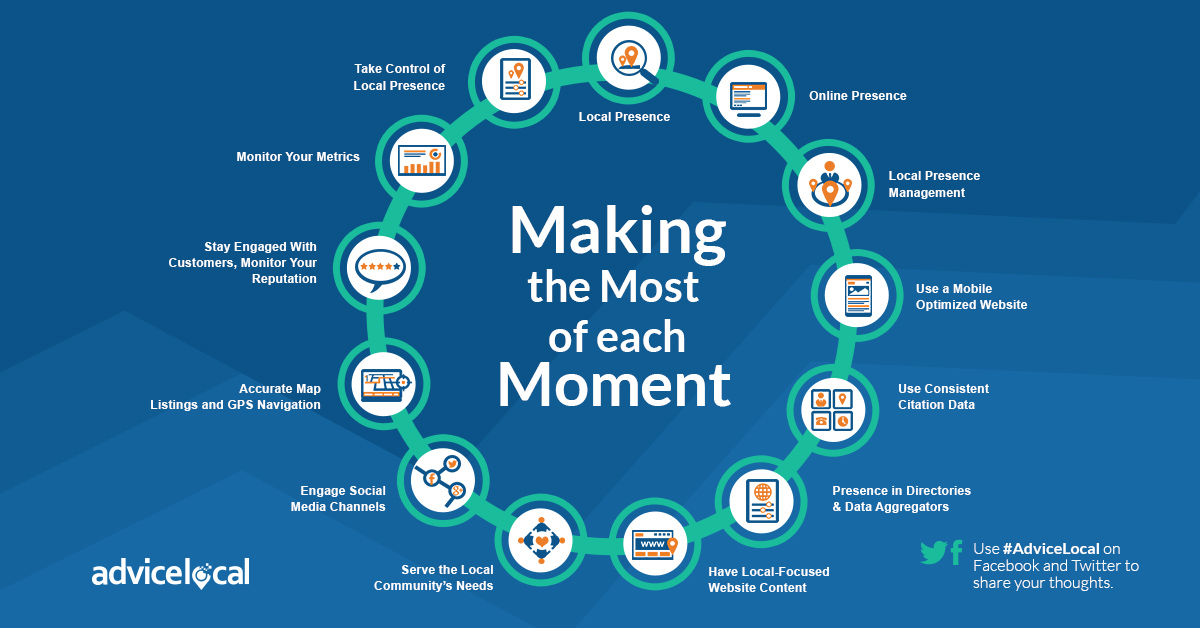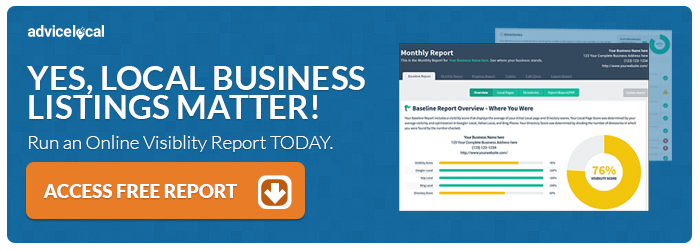Do you realize how many moving pieces and parts make up a business’ local presence management strategy? Each of these pieces and parts serve as building blocks, sometimes on top of each other, and sometimes just adjacent. To make the most of each moment, you must first understand what local presence management is. Within this article, What is Local Presence Management, I define in detail what local presence management is and touch on why it is important.
Today, I want to discuss with you the components (the pieces and parts mentioned above) that make up a local presence management strategy. But first, for those of you new to local presence management, let’s talk about the foundation.
The Foundation of a Local Presence Management Strategy
- Local Presence – This refers to all of the information surrounding a business’ actual physical location, such as where to find it on a map, business hours and its NAP data.
- Digital Presence – This refers to all of the information, processes and marketing for a business presented online. Consumers usually conduct a Google search to find this information, which includes the website, any social media pages, blogs, online reviews, any search engine optimization (SEO), and pay-per-click (PPC) advertising, just to name a few.
Why Do Businesses Need a Local Presence Management Strategy?
Well, the simple answer is because local businesses want and need to be found in local searches by the consumers seeking their products or services.
Another way to say it is, local businesses need a local presence management strategy to ensure there is a seamless merging of local and online presence, to positively affect and cultivate a brand or business’ presence in search engines.
A Look at a Comprehensive Local Presence Management Strategy
Keep reading for the core 10 components that must be considered to have an effective local presence management strategy.
1. A Website Optimized for Mobile
In 2015, Google announced mobile search had overtaken desktop, which means consumers are making more and more buying decisions from the small screen. Make sure a business is ready to serve their target audience by having:
- A mobile-first website that loads quickly
- Clear call-to-action buttons to help consumers contact the business (Click-to-call or Click-to-email)
- Special offers for mobile consumers to increase engagement and brand loyalty
Since 2015, search engines have continued to reinforce the importance of a mobile-first website, and the just-released Google Speed Update supports that. In the past, Google focused primarily on the speed of websites on desktop when it came to ranking pages. This update is based specifically on the speed in which a website loads on mobile devices. According to Google, “starting in July 2018, page speed will be a ranking factor for mobile searches.”
This update, like many of their others, prioritizes providing consumers with what they want in the moment. People want to be able to find answers to their questions as quickly as possible, and this update will ensure that websites placing in the top of search results are doing just that. I have talked with you before quite a bit about moments — it’s these micro-moments that are the driving factor behind mobile searches.
2. Consistent Citation Data
Having consistent citation data — name, address, phone number (NAP) and business hours — makes it easier for search engines and consumers to find businesses. As a reminder, a citation is any mention of a business, anywhere online. They affect website authority, which affects search placement. And having a top spot in results, like placement in Google’s Local Pack, means more consumers have the opportunity to interact with the business or brand.
3. An Optimized Online Presence in Relevant Directories & Data Aggregators
All local brands should be listed on major directories such as Google Business Profile (formerly Google My Business), Bing
Places and Yellow Pages. Many of these citations are created on the fly and must be claimed by a representative for the business in order for it to be beneficial. Submission to major data aggregators also gets business listings into many major directories, all at once, increasing local visibility.
To increase the chances of being found by consumers, businesses should also list in niche directories for their industry. For example, attorneys would benefit greatly from being listed in FindLaw or Justia, while realtor.com is an ideal niche directory for real estate agents.
4. Local-Focused Website Content
Businesses with multiple service areas, stores or venues need to have separate pages for each location, known as location pages. And local business websites should make references to their geographic areas in their content and SEO-friendly page elements, such as page titles and headers. Examples of content with a local focus include:
- a heating contractor addressing the local climate in posts
- a hotel addressing nearby attractions and activities and ways the hotel helps guests get there
This carefully crafted website content should also be shared on a brand’s social media pages to engage with the locals, too.
5. Serve the Local Community’s Needs
A local business is a part of the community it serves, and providing helpful or entertaining information is one way a business can give a boost to its local presence. Businesses should also get involved in their communities by finding causes or complementary businesses to partner with, in order to engage new customers and to solidify their presence in the minds of consumers. While building relationships with the people, successful businesses will make it a point to include community influencers in their efforts, too.
6. Engaging Social Media Channels
We consistently hear that it difficult to measure the ROI of social media, but this does not mean the channels should be ignored. Providing helpful information, like infographics about an industry, or holding contests and posting deals and specials, will likely to catch the eye of consumers who will share the information with their networks. In the same way community involvement draws in locals, having lively and relevant social media pages creates new fans and followers, which can and will drive traffic to brick-and-mortar locations.
7. Mapping Applications and GPS
Consumers have to be able to find a business to engage with it. Ensuring the business is correctly located on Google Maps and in syndicated listings for mapping companies that populate GPS devices is a key component of local presence management. Make sure the business is claimed where relevant, and verify that they’re showing up correctly on maps and GPS devices. If you can’t find the business, the consumer won’t be able to either.
8. Reputation Management
A sharp lookout for businesses in various media is absolute necessary. Whether checking review sites to ensure customers are taken care of or watching Twitter to see if the brand or industry is trending, businesses must remain engaged. A brand can go from hero to zero with one rogue post or lack of response in a timely manner.
Listen carefully: operate according to preset “best practices” and involve professional reputation management services where necessary. Consumers want to work with trustworthy businesses, and maintaining a healthy online image plays a huge role in that.
9. Monitor those Metrics
In the world of local presence management, we can’t neglect the conversion aspects of a strategy. Having creative and informative content is only one part of a larger puzzle. Knowing important details, like where website traffic is coming from, how long visitors remain on certain pages and if consumers respond to calls to action, help determine what to do with the business’ content. Utilize free applications like Google Analytics and Google Search Console. They are worth their weight in gold for monitoring this vital information.
10. Taking Control of a Business’ Local Presence
Presenting accurate data to the right sources is both the first and final puzzle piece in customer service. Consumers can only engage online with businesses and brands they can easily find; this means a basic search for industry or category, or a direct query for a business name needs to bring them up on page one.
Consistent NAP data, business hours, properly listed locations, relevant content, and properly targeted keywords and phrases will help the business do well in local search results.
You Have Taken the First Step
Taking control of a business’ or multi-location brand’s local presence is just the first step. A plan for continued monitoring and measurement is critical to the success of any local presence management strategy — this is where Advice Local comes in.
Our one-stop local presence management solutions give control back to businesses and their representatives with an easy way to monitor, report and control their data. We can complete all the steps mentioned above, or provide services á la carte. Request a demo today.




